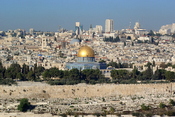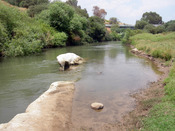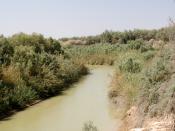Jerusalem, one the world's oldest and holiest cities, was in December 1949 proclaimed by the state of Israel to be its capital. The city plays a central role in the spiritual and emotional perspective of the three major monotheistic religions. For Jews throughout the world, Jerusalem is the focus of age-old yearnings, a living proof of ancient grandeur and independence and a center of national renaissance; for Christians, it is the scene of their Saviour's agony; for Muslims, it is the goal of the prophet Muhammad's mystic night journey and the site of Islam's most sacred shrines. For all three faiths it is a center of pilgrimage- the Holy City, the earthly prototype of the heavenly Jerusalem.
To the east, Jerusalem looks down on the Dead Sea and across the Jordan River to the arid mountains of Jordan; to the west, it faces the coastal plain and the Mediterranean Sea, about 58 kilometers away.
The main north-south road bisects the city in its course along the watershed between the coastal plain and the Great Rift Valley of the Jordan River and links Nabulus to the north of Bethlehem, Hebron, and Beersheba to the south. The west-east road from Tel-Aviv crosses the Jordan north of the Dead Sea. A newer transversal road leads westward from Jerusalem, eventually converging on the Ben-Gurion Airport at Lod. Lying on the watershed between the relatively rainy Hills of Judaea and the dry Jurdaean desert, Jerusalem has both Mediterranean and Irano-Turanian vegetation. The various red and brown Mediterranean soil, formed by the different types of limestone chalk covering the hills, support as many as 1000 plant species.
The earliest traces of human settlement in the city area, found on a hill to the southeast, are from the late Chalcolithic Period and Early Bronze Age (3000...


